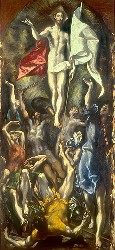
What a choice. I’m in New York for the weekend with Murray and friends. Not wanting to wear thin the patience of those who are not art fanatics, I must choose one show, preferably one they and I will enjoy.
One gallery show offers enough meat for too much travel and no guarantee of quality. I need to protect my relationships. Galleries are not an option, here.
The big choices are El Greco at the Met and James Rosenquist at the Guggenheim. Hmm.
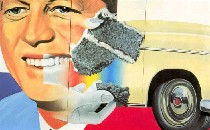 Case for Rosenquist–still an influence; billboard art is still happening; merging of disparate images still everywhere but few mergers are as successful as JR; reviews mixed.
Case for Rosenquist–still an influence; billboard art is still happening; merging of disparate images still everywhere but few mergers are as successful as JR; reviews mixed.
Case for El Greco–still an influence and Velasquez/Manet exhibition, good point of comparison, is still fresh in my mind; reviews mixed, but less so.
El Greco wins.
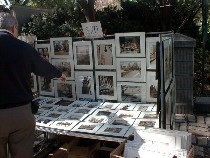 But going to a show in New York, to us outsiders, is never totally about the show. It’s also about taking a bit out of the Big Apple lifestyle–the walk across Central Park, kicking leaves, the array of artists selling their own work outside the museum along Fifth Avenue. The weather is brisk and so is business.
But going to a show in New York, to us outsiders, is never totally about the show. It’s also about taking a bit out of the Big Apple lifestyle–the walk across Central Park, kicking leaves, the array of artists selling their own work outside the museum along Fifth Avenue. The weather is brisk and so is business.
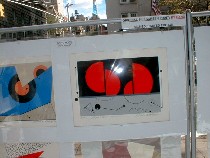 The work outside tends toward the safe and familiar–photos of New York, prints that look like something you’ve seen before. But out there it all looks attractive, and the price is right for bits of wall candy.
The work outside tends toward the safe and familiar–photos of New York, prints that look like something you’ve seen before. But out there it all looks attractive, and the price is right for bits of wall candy.
 Every once in a while, someone’s work looks a little different, or if not different, especially beautiful (shown right, Joe Borg’s prints and mixed media). Big gallery prices do not apply here. Some of the prints go for as little as $10 or $25.
Every once in a while, someone’s work looks a little different, or if not different, especially beautiful (shown right, Joe Borg’s prints and mixed media). Big gallery prices do not apply here. Some of the prints go for as little as $10 or $25.
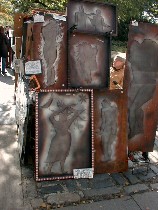 Safe art is not the only approach. P. Robinson-Smith (shown left) has an unusual, crafty thing going with wire screening. With an amazing amount of control over a fractious material, he’s making reliefs–mostly nudes and animals . Are people buying? He says , two or three a week–enough to bring him down from Vermont every other weekend. His prices? From $80 to $1,500.
Safe art is not the only approach. P. Robinson-Smith (shown left) has an unusual, crafty thing going with wire screening. With an amazing amount of control over a fractious material, he’s making reliefs–mostly nudes and animals . Are people buying? He says , two or three a week–enough to bring him down from Vermont every other weekend. His prices? From $80 to $1,500.
Back to El Greco, born Domenikos Theotokopoulos in Crete in 1541. So, once again I faced up to my ignorance. It never occured to me that El Greco was called El Greco because he was a Greek painting in Spain.
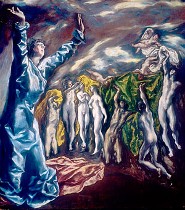 For those of you who like to place people in time, he and Velasquez were painting during the Spanish Inquisition (it’s your moment here to wonder at how avid religiosity and its evil twin coexisted), with Velasquez trailing by about 50 years.
For those of you who like to place people in time, he and Velasquez were painting during the Spanish Inquisition (it’s your moment here to wonder at how avid religiosity and its evil twin coexisted), with Velasquez trailing by about 50 years.
While El Greco painted some god-awful paintings, the thing the show brought home to me is his brilliance and ambition. The daring compositions of the religious paintings undulate toward the sky.
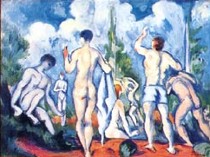 He fearlessly realigned anatomy, nature and perspective to suit his compositional and conceptual purposes, and those decisions resonated 300 years later in the work of Paul Cezanne (“Bathers,” left) who also fractured anatomical, natural and perspectival truth.
He fearlessly realigned anatomy, nature and perspective to suit his compositional and conceptual purposes, and those decisions resonated 300 years later in the work of Paul Cezanne (“Bathers,” left) who also fractured anatomical, natural and perspectival truth.
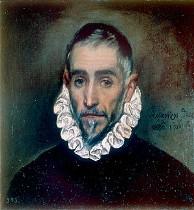 His portraits bring to mind the portraits in the MoMA show, Velasquez/Manet, and place Velasquez in less of a ground-breaking role than the MoMA show implied. The realism and psychological depth of Velasquez’s faces, the dark, ambigous backgrounds, all made it into El Greco’s work.
His portraits bring to mind the portraits in the MoMA show, Velasquez/Manet, and place Velasquez in less of a ground-breaking role than the MoMA show implied. The realism and psychological depth of Velasquez’s faces, the dark, ambigous backgrounds, all made it into El Greco’s work.
 And the society portraits of John Singer Sargent also seem to have El Greco as a forebear. If you get to the show, check out the brush work on the fur in this thoroughly modern woman (left, “A Lady in a Fur Wrap”), perhaps by El Greco. Well, perhaps enough to include it in the show.
And the society portraits of John Singer Sargent also seem to have El Greco as a forebear. If you get to the show, check out the brush work on the fur in this thoroughly modern woman (left, “A Lady in a Fur Wrap”), perhaps by El Greco. Well, perhaps enough to include it in the show.
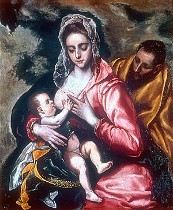 El Greco’s paintings are a record of a mind reaching ever further to create something new, to make his thinking concrete. And speaking of concrete, the clouds and skies call to mind plaster and concrete, giving a literal interpretation to the word firmament. And sometimes the skies go plain old abstract, taking on the materiality of the paint. I’d say that was influential.
El Greco’s paintings are a record of a mind reaching ever further to create something new, to make his thinking concrete. And speaking of concrete, the clouds and skies call to mind plaster and concrete, giving a literal interpretation to the word firmament. And sometimes the skies go plain old abstract, taking on the materiality of the paint. I’d say that was influential.
I just have to get over some of the religious imagery, which is so ecstatic it verges on the gruesome. It’s an achievement and an embarrassment all at once. If not for all the holy cards making these images familiar, I think some of them would be be conscripted to the bin of best-to-be-forgotten art history..
image copyright information










